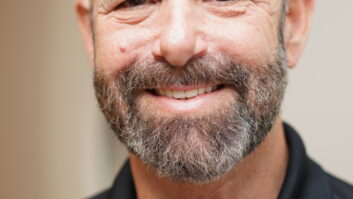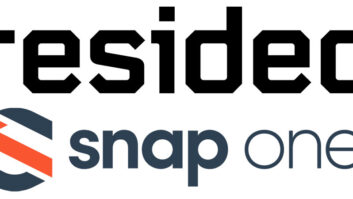When Kevin Kelly and Mark Wilkins look to one side, they see an AV integration business in flux as residential dealers look for new geographical and service markets to grow their way out of a still-tentative economic landscape. Looking the other direction, they see a pro AV manufacturing sector with more products and systems than ever before but output increasingly exceeds its ability to properly market all that new technology across every possible silo and application. And in between those two forces is exactly where Kelly and Wilkins, the president and CEO, respectively, of AV distributor Stampede Presentation Products, want to be.

Despite the expansion of its product lines in recent months, with more planned, specialization is still the key to Stampede’s future as it celebrates its 15th anniversary this year. Pictured on the left side of the table are Stampede’s Pete Denes and Kevin Kelly. On the right side are Jeff Willis, in front of Tom Keefe.
Stampede, based in Amherst, NY, a few miles north of Buffalo, celebrates its 15th anniversary in 2012. The company enters that milestone year after having invested more than $10 million in the business in 2011 alone and adding more than 35 new lines since 2010 to its 9,000-plus dealers. This year, Stampede plans several initiatives that it says will solidify and extend the gains it made in the last several years. These include increasing its technical support staff to 10 from the present six members; increasing inventory levels for existing and additional products and manufacturers; leveraging its relationship with its financial partners, including HSBC, to increase the amount of credit that it can offer dealer customers; expanding relationships with customers with a new Vendor Portal program that takes the entire transaction securely online; and expanding its Stampede University training program to include more business-oriented courses and a consulting program designed to help its residential dealers develop commercial markets.


When Stampede CEO Mark Wilkins (left) and president Kevin Kelly look to one side, they see an AV integration business in flux, as residential dealers look for new geographical and service markets to grow their way out of a still-tentative economic landscape. Looking the other direction, they see a pro AV manufacturing sector with more products and systems than ever before , but output increasingly exceeds its ability to properly market all that new technology across every possible silo and application.
It’s a full agenda, but Kelly and Wilkins say that’s what it takes to maintain a position as a bridge between dealer and manufacturer, something that Wilkins, a U.K. native, said distributors in Europe have traditionally been more assertive about than their U.S. cousins.
“Part of our mission is that not only do we offer a value to our customers but also we have to offer value to our suppliers,” he stated. “So some of the things that you’re seeing there work both ways. Part of the value we offer to a manufacturer through Stampede University is through educating the marketplace in new technologies. That’s part of our value to a manufacturer…and to the dealer who’s being educated. If a [speaker] manufacturer came to us and said, ‘Hey, we’re interested in telling all these dealers about our new system, can you get to everybody that sells a large-screen display?’ We can narrow down our base to actually come up with a target audience, and then we have the technology through either webinar or [other means], to then educate those dealers.”
The fact that some manufacturers have established their own distribution channels, rather than reinvesting those resources into new products has actually dissipated their energies, Wilkins believes. “Kevin and I spend a huge amount of our time actually convincing manufacturers that we’re not just a credit warehouse, but rather an extension of their sales and marketing divisions, so we will actually work at going out to create a sales channel, an extension of their sales and marketing division,” he said.
That kind of assertive strategy will also be visible in another strategy Stampede will implement in 2012, which will be to embed employees at key customers’ sites where sales volume merits the cost, to facilitate orders, troubleshoot dealer and end-user issues, train staff, and introduce new opportunities into the dealer sales force. It’s also a way to import some of Stampede’s growing knowledge base directly into its clients’ technical culture, a pool of knowledge that was expanded last year with the company’s acquisition of Spire Global and its exclusive Sony videoconferencing service into the B2B equivalent of a mass-market proposition. Kelly says that’s helped bolster Stampede’s IT expertise, an area that will become more important in residential AV systems in the future. And, Wilkins added, “If we don’t have [certain] expertise already, we’re very interested in acquiring it,” hinting at additional acquisitions that the company expects will occur in the next several years as part of its expansion strategy.

The Stampede warehouse at its Amherst, NY, headquarters.
The Borderline
Residential and commercial AV integrators have sometimes eyed each other warily as the recession compelled some to cross over into the other’s territory in search of revenue. Kelly believes that market dynamics and expertise levels have largely held that phenomenon in check.
“The more sophisticated the commercial job is, the more sophisticated the reseller needs to be in order to handle it, so a lot of that process works itself out during the bid and the specification process,” he explained, adding that, “A growing portion of consumer dealers are doing commercial business, and it’s a growing portion of their overall business, simply because of the impact of the recession on discretionary [spending] as well as the new-home market.” In fact, Wilkins said, “I actually think it’s tougher to do a residential job than it necessarily is to do a commercial job. You find that if you can cope with a big residential installation, then usually you can do a corporate installation.”
In that context, Stampede’s plan to add a consulting program that will counsel residential integrators as they enter the commercial space makes practical sense. Kelly says a big part of that will revolve around training and product awareness, but it will also include engineering services that will help residential integrators “bridge the gap on certain technologies, like a high-end switching system, that will enable a dealer to go ahead and take on a project and do different parts of it.”
Wilkins acknowledged that there is some sensitivity from the two channels, but likens it to how the overall AV integration sector has regarded perceived competition from the IT value-added reseller (VAR) side. “There’s no difference from 10 years ago when the whole pro AV market started getting worried about the IT dealer coming in and taking their business away,” he pointed out. “End users will always find a way to buy a product, and they’ll buy it from the person they’re the most comfortable with. If a pro AV dealer isn’t offering the right services to the end user then frankly he’s the person that should be worried, If he’s losing business to a residential dealer coming in, then he should be looking squarely at his own business and not necessarily at the threat from the residential dealer.”
Credit is the Key
Perhaps the most striking tactic in Stampede’s arsenal is how it offers lines of credit to its customers. Kelly said the idea comes from their understanding that the AV integration business is anything but consistent in terms of payment to integrators.
“Our goal is customize a solution that enables the dealer to do business [consistently],” he explained. “So we’re very, very proud that our crediting works with our dealers to be a real resource, versus a very straight-line approach, which is, ‘Your limit is X and the terms are Y, and you must fit into that box.’”
And Kelly attributes credit availability as a driving force in the company’s growth, especially in the context of the larger economy. “This is one of the reasons why our dealers are loyal to us, one of the reasons why our dealers will continue to go with our recommendations, to go with the products that we recommend and spec for certain situations,” he said. “If we just spent all of our time helping them get the right products, getting special commercial pricing for them, determining a roll-out schedule, but we didn’t help them on the back end, what the project is and what this means from a credit standpoint, we wouldn’t be doing the full job.”
But despite the expansion of product lines in recent months, with more planned, specialization is still the key to Stampede’s future, according to Wilkins. “We do intend to stay specialists,” he said. “It’s important to note that we are a pro AV distributor, and we will carry on selling displays as our core product, and then we’ll build around it. When we do acquisitions, we are looking at acquisitions of technologies that complement the pro AV dealer or the pro AV integrator. We’re not looking to go and sell washing machines.”
Dan Daley is a freelance writer in Nashville, TN.







